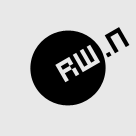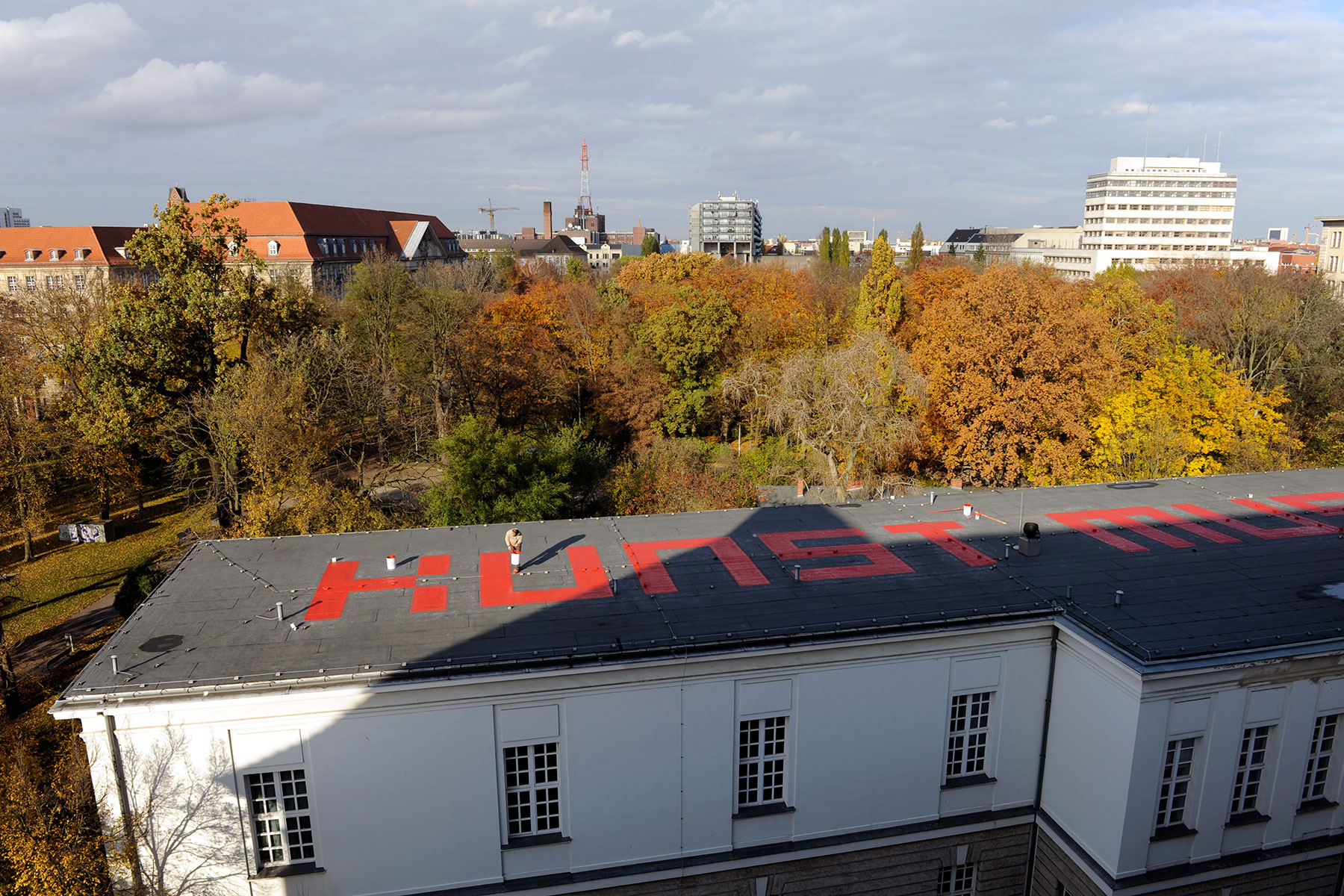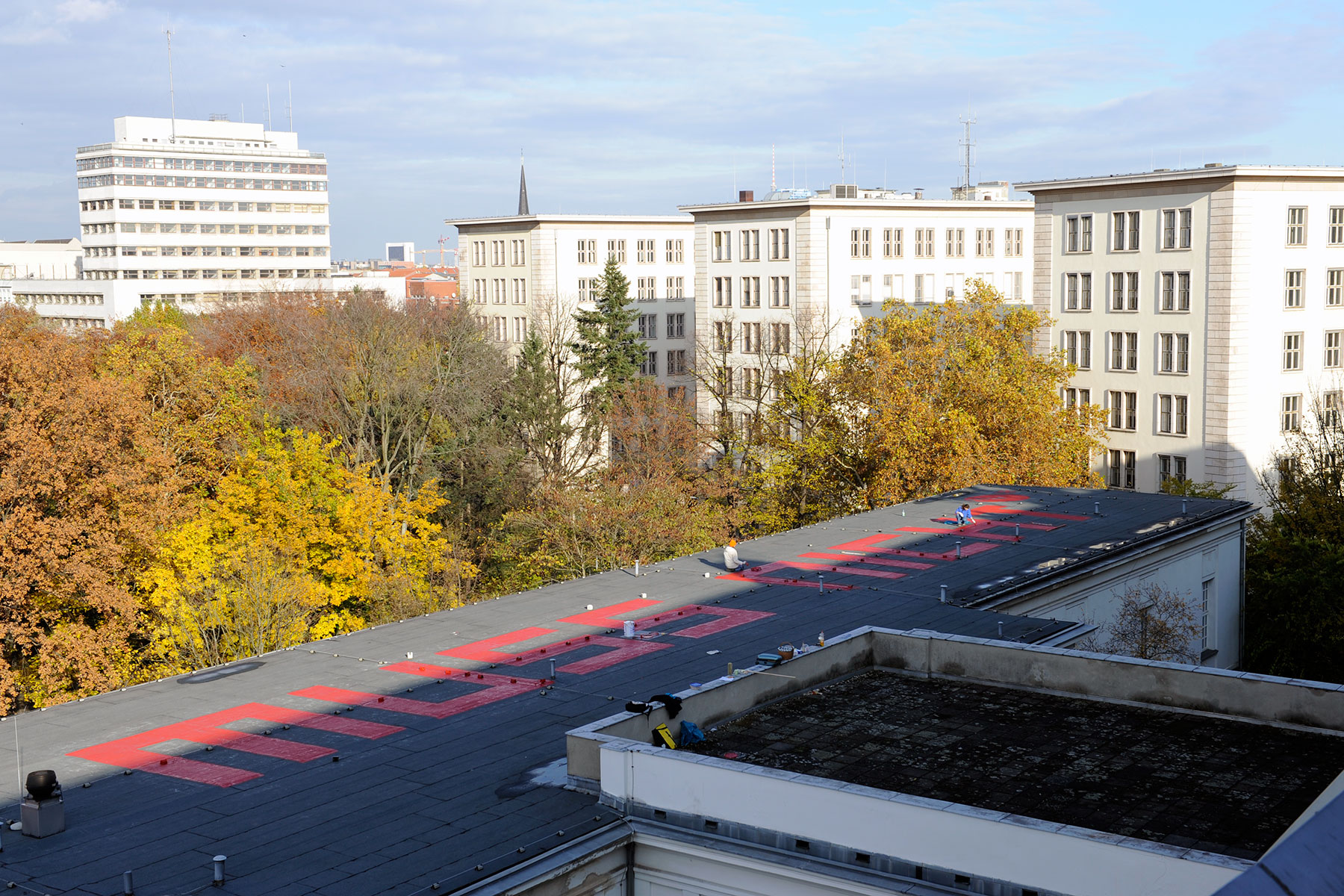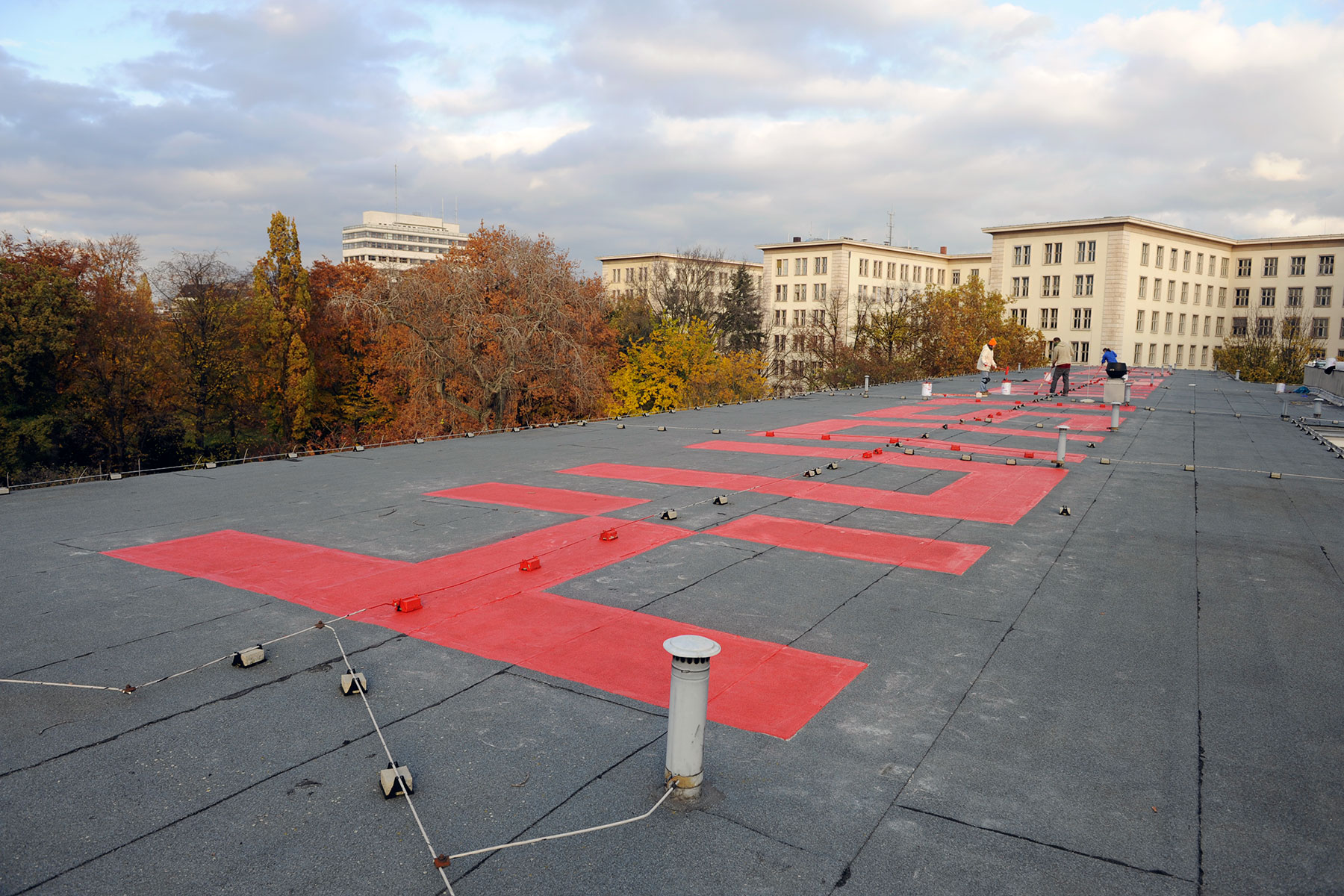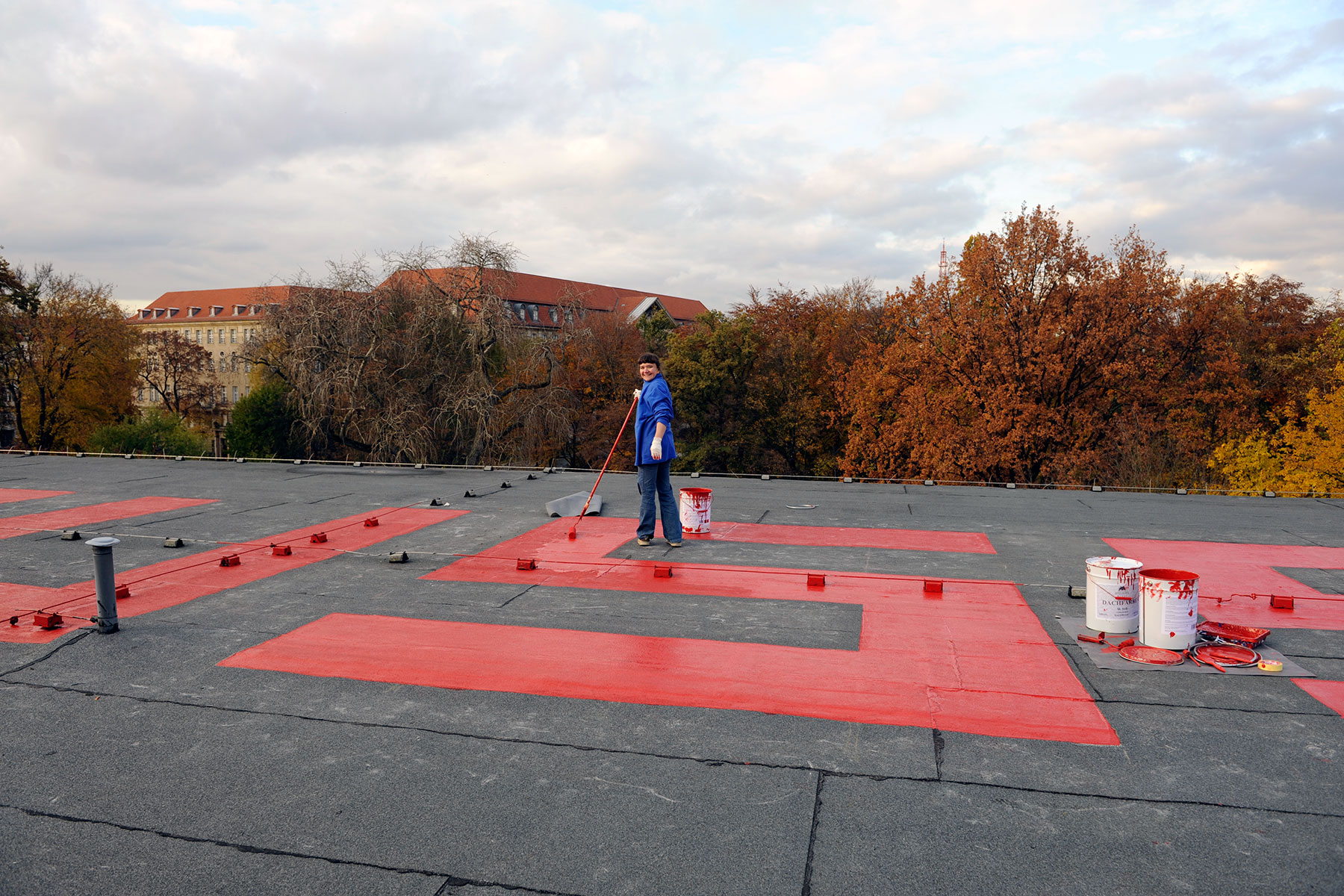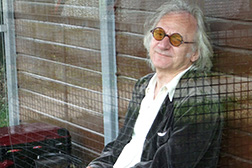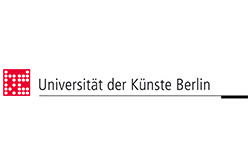With KUNST MUSS NICHT (art mustn’t must) on the roof of Berlin’s University of Arts, Siegfried Zielinski speaks out against a rising instrumentalization of art that starts at art academies already.
Installed | Location | GPS: 13-09-2009 | UDK, Universität der Künste, Berlin, Germany | 52.4911,13.3587342
Author | Words: Prof. Dr. Siegfried Zielinski | KUNST MUSS NICHT
Roof Size | Font Size: 996qm | 5m x 71m
On Air: Google Maps 2012, Apple Maps 2013, Bing Maps 2014
Interview
KUNST MUSS NICHT | Siegfried Zielinski, Berlin 2009
Making the Possible ‘Impossibler’
REMOTEWORDS: ART MUSTN’T MUST on the roof of the Berlin University of Arts takes a stand against the increasing utilization of the arts. Does this utilization already begin at educational institutions?
Siegfried Zielinski: That’s why I chose these three words. At art schools and academies, art is already today engulfed in departments for strategic marketing, economic communication, insistent questions of social relevance, early contextualization or even offers of social security for young developing artists, and often at an early stage when they haven’t really been able to decide if they have the talent and the strength to work as future freelance artists. The annual tours at the academies between Leipzig, Berlin and Düsseldorf are hardly distinguishable from actual group exhibitions. The market, the economy and politics constantly fabricate a highly flexible framework of activity within which art is supposed to revolve, as if given refuge in a padded cell.
REMOTEWORDS: That’s a great image: a padded cell in which art can sow its wild oats without any danger to, or consequences for, itself and others. So, more opportunities for budding artists do not necessarily lead to better art?
Siegfried Zielinski: In no way. Above all, there is no built-in automatism. Over the past 20 years I have traveled to many countries around the globe and often seen great art that was produced under the most impossible conditions: in Columbia, for instance, in Hungary, in Uruguay or, recently, in Shanghai. I in no way want to advocate producing these same blatantly horrific conditions in the western and northern countries so that interesting art can become possible. But with us, force of necessity as an across-the-board law has reached the same circular conclusiveness of our political and economic relationships and, long ago, also the academies and art practice in general. Where everything has become possible, it is essential to start thinking more about how to make the possible ‘impossibler’.
REMOTEWORDS: It will certainly not be easy to impossiblize the possible and even to communicate this to the outside world. How would this turn out? In this context I recall your Bataille-ish appeal to give art a chance at “extravagance”. Can you explain this apparent contradiction more precisely?
Siegfried Zielinski: Artistic activity versus the omnipotent force of necessity and instrumental rationality requires us to go all out for extravagance, for expenditure. Bataille developed this category as an alternative to productivity madness. He suggested that surpluses that come about in production should not be sent back to the rotating accumulation machinery but instead be ‘wasted’ on a gesture of luxuriousness. As long as the institution that we call society does not understand that high-level art studies and experiments can only be had at the price of a wasteful extravagance of resources, our slogan is valid: ART MUSTN’T MUST. Writing this with buckets of red paint by wind and weather on the roof of the University of Arts’ Haus Salomon was a direct act of extravagance.
„Mögliches unmöglicher machen“
REMOTEWORDS: KUNST MUSS NICHT auf dem Dach der Universität der Künste Berlin wendet Sie sich gegen eine zunehmende Utilitarisierung der Künste. Beginnt diese bereits in den Ausbildungsstätten?
Siegfried Zielinski: Deshalb habe ich diese drei Wörter ausgewählt. Bereits in den Hochschulen und Akademien ist Kunst heutzutage dicht umstellt von Abteilungen für strategisches Marketing, Wirtschaftskommunikation, drängenden Fragen nach gesellschaftlicher Relevanz, frühzeitiger Kontextualisierung oder sogar Angeboten der sozialen Fürsorge für junge werdende Künstler, und zwar bereits in einem Stadium, in dem sie noch gar nicht wirklich entscheiden konnten, ob sie künftig als freie Künstler zu arbeiten das Talent und die Kraft haben. Die jährlichen Rundgänge an den Akademien zwischen Leipzig, Berlin und Düsseldorf unterscheiden sich kaum mehr von aktuellen Gruppenausstellungen. Markt, Ökonomie und Politik stellen ständig einen hochflexiblen Handlungsrahmen her, in dem sich Kunst zu bewegen hat wie in einer wohl behüteten Gummizelle.
REMOTEWORDS: Ein tolles Bild: Eine Gummizelle in der die Kunst sich ohne Gefahr und Konsequenzen für sich und andere austobt. Mehr Möglichkeiten für angehende Künstler führen also nicht unbedingt zur besseren Kunst?
Siegfried Zielinski: Keinesfalls. Vor allem steckt darin kein Automatismus. Ich war in den letzten 20 Jahren in vielen Ländern der Erde unterwegs und habe oft großartige Kunst gesehen, die unter den unmöglichsten Bedingungen entstehen musste, in Kolumbien zum Beispiel, in Ungarn, in Uruguay oder jüngst in Shanghai. Keineswegs möchte ich dafür plädieren, in den westlichen und nördlichen Ländern Bedingungen herzustellen, die zum Himmel schreien, nur, damit spannende Kunst möglich wird. Aber bei uns hat der Sachzwang als alles umfassendes Gesetz, hat die zirkuläre Vollschlüssigkeit der politischen und ökonomischen Beziehungen längst auch die Akademien und die künstlerische Praxis erfasst. Wo alles möglich geworden ist, kommt es darauf an, verstärkt darüber nachzudenken, wie man das Mögliche unmöglicher machen kann.
REMOTEWORDS: Es ist sicher nicht leicht, Mögliches unmöglich zu machen und dies auch noch nach außen zu kommunizieren. Wie könnte das aussehen? In diesem Zusammenhang erinnere ich mich an Ihren Bataille’schen Appell, der „Verschwendung“ für die Kunst ein Chance zu geben. Können Sie mir diesen scheinbaren Widerspruch etwas genauer erläutern?
Siegfried Zielinski: Künstlerisches Handeln wider die Allherrschaft des Sachzwangs und instrumenteller Vernunft setzt die Bereitschaft zur Verschwendung, zur Verausgabung voraus. Bataille hat diese Kategorie als Alternative zum Produktivitätswahn entwickelt. Er schlug vor, dass die Überschüsse, die in der Produktion erzielt werden, nicht zurück in die rotierende Akkumulationsmaschinerie geschickt werden, sondern in einem Gestus des Luxuriösen verschwendet werden. Solange die Institution, die als Gesellschaft bezeichnet wird, nicht versteht, dass künstlerische Studien und Experimente auf hohem Niveau nur um den Preis der Verschwendung von Ressourcen zu haben sind, hat unser Slogan Gültigkeit: KUNST MUSS NICHT. Ihn mit Eimern roter Farbe bei Wind und Wetter auf das Dach des Hauses Salomon der Universität der Künste zu schreiben, war ein unmittelbarer Akt der Verausgabung.
